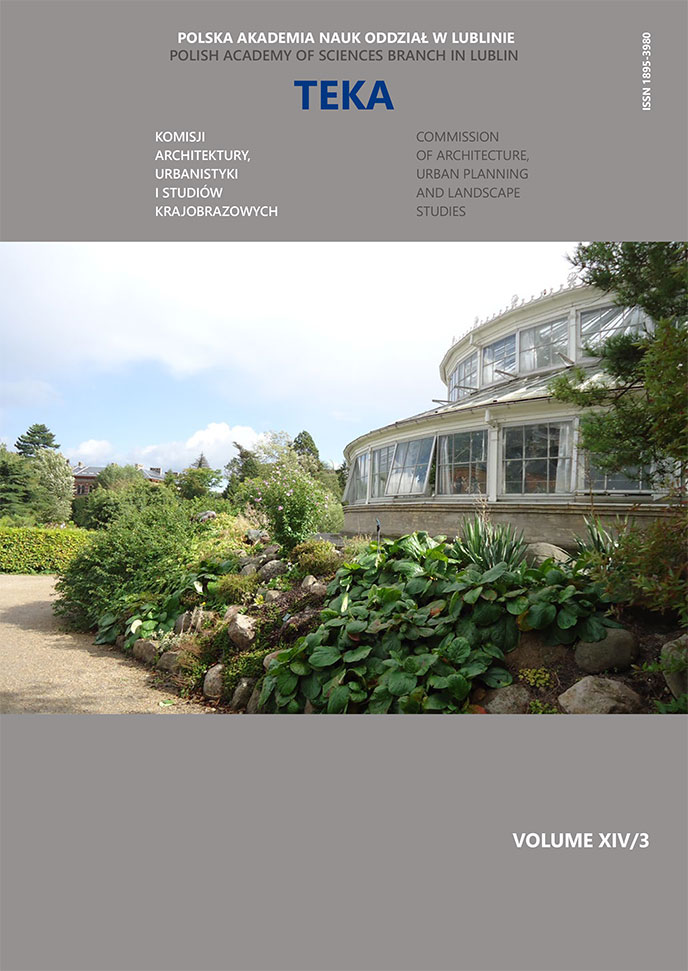Art in public space as a tool of social inclusion
Article Sidebar
Open full text
Issue Vol. 14 No. 3 (2018)
-
Psychological aspects of architecture and urban planning in crime prevention
Michał Skorupski, Joanna Jabłońska7-14
-
“Policyjny Dom Zdrowia” (P.D.Z., Policemen’s Health Center) as the example of a big sanatorium facility in the valley of the Prut River in the Hutsul region
Jacek Czubiński15-23
-
Adaptive reuse of commercial and public buildings in Wroclaw Old Town in Poland. The occupant’s safety and comfort versus preservation of authenticity of monumental buildings
Krystyna Kirschke, Paweł Kirschke, Elżbieta Komarzyńska-Świeściak24-41
-
Compositional situation: analysis of the location of two sculptures in Mexico City
Leszek Maluga42-49
-
Art in public space as a tool of social inclusion
Agnieszka Chęć-Małyszek50-60
-
Origins of the Kalinowszczyzna district in Lublin: history, design principles and current condition
Michał Dmitruk61-70
-
Emotional reactions of the respondents compared to different ways of perceiving the square in front of the WICA building of the Lublin University of Technology
Olga Skoczylas71-78
-
Psychosomatic aspects of healthcare facility design solutions
Ewa Pruszewicz-Sipińska, Agata Anna Gawlak, Magda Matuszewska79-88
-
Residential buildings in healthcare resort Szczawno-Zdroj in the second-half of 20th century
Marek Piróg89-95
-
Brześć – the city of an eastern borderlands, architecture of the 2nd Republic of Poland
Krystyna Paprzyca96-101
-
Spatial concepts of the work environment
Grzegorz Schnotale102-108
-
The earliest public green areas connected with Jelenia Góra, part. 2
Marzanna Jagiełło, Wojciech Brzezowski109-118
-
The Wrocław urban planning from general plans to studies on land use planning
Robert Masztalski, Piotr Kryczka119-136
-
Architecture of tourist and leisure facilities on the Kłodzko-Orlice borderland, on the example of Zieleniec and Lasówka
Jacek Suchodolski137-155
Archives
-
Vol. 16 No. 4
2020-12-30 11
-
Vol. 16 No. 3
2020-09-30 10
-
Vol. 16 No. 2
2020-06-30 11
-
Vol. 16 No. 1
2020-03-31 10
-
Vol. 15 No. 4
2019-12-30 6
-
Vol. 15 No. 3
2019-10-31 9
-
Vol. 15 No. 2
2019-06-28 12
-
Vol. 15 No. 1
2019-03-29 13
-
Vol. 14 No. 3
2018-10-28 14
-
Vol. 14 No. 2
2018-06-29 14
-
Vol. 14 No. 1
2018-03-30 13
-
Vol. 13 No. 4
2017-12-29 8
-
Vol. 13 No. 3
2017-09-29 9
-
Vol. 13 No. 2
2017-06-30 10
-
Vol. 13 No. 1
2017-03-31 10
-
Vol. 12 No. 4
2016-12-30 12
-
Vol. 12 No. 3
2016-09-30 10
-
Vol. 12 No. 2
2016-06-30 9
-
Vol. 12 No. 1
2016-03-31 8
Main Article Content
DOI
Authors
Abstract
What would art be if it were not viewed by people and could not influence the environment? Without the audience and spectators, it would be nothing, therefore it should be accessible and “graspable” for everyone. Elements of art placed in urban space have always enriched the “urban tissue”, providing man with many positive experiences. They enter into a dialogue with the city’s inhabitants, contribute to the growth of the its potential, and at the same time, influence all the senses of human beings. Art in urban space influences the perception of its audience, encourages dialogue, and creates a platform for better understanding of people’s needs and their functioning in the public sphere. It also plays an important role in the process of socialisation of the society, regardless of where it is exhibited.
Keywords:
References
Chmielewski J. M., Teoria urbanistyki w projektowaniu i planowaniu miasta. Oficyna Wydawnicza Politechniki Warszawskiej, Warszawa 2001, s. 51−53.
Drozd G., Obudzić śpiącą bestię, „Miejsca transformacji”, „Krytyka Polityczna” 27−28/2011, s. 58.
Erbel J., Herbst K., Sztuka w przestrzeni publicznej. Raport z badania, w: Liberated Energy, J. Baranowska, P. Sztarbowski (red.), Instytut Teatralny im. Zbigniewa Raszyńskiego, Warszawa 2011, s. 154−171.
Franczak K., Demokratyczny potencjał sztuki w przestrzeni miejskiej, w: O miejskiej sferze publicznej. Obywatelskość i konflikty o przestrzeń, M. Nowak, P. Pluciński (red.), korporacja ha!art, Kraków 2011, s. 260-261.
Gehl J., Miasta dla ludzi, Wydawnictwo RAM 2014, s. 178−179.
Golka M., Socjologiczny obraz sztuki, Poznań 1996, Ars Nova, s.190−197.
Iwański M., Jakubowicz R., Rewitalizacja czy gentryfikacja poznańskiego Chwaliszewa, „Przegląd Anarchistyczny”, nr 12, 2011, s. 257.
Kabakow I., Projekt publiczny albo duch miejsca, w: E. Rewers (red.), Miasto w sztuce – sztuka miasta, Kraków 2010, Universitas, s. 347.
Krause K. Ch., Public art: Theory, practice and populism, Malden, Oxford, Carlton 2008, Blackwell Publishing.
Miwon K., Sztuka publiczna w przestrzeni: integracja czy interwencja, „Kultura Współczesna”, nr 4, 2009, s. 103−131.
Nawratek K .., Miasto jako idea polityczna, korporacja ha!art, Kraków 2008, s. 74.
Ossowski S., Wybór pism estetycznych, wprow., wyb. i oprac. Bohdan Dziemidok, Kraków2004, Universitas, s. 116.
Read H., Wychowanie przez sztukę., J. Bielecki, Osobowość młodzieży niepełnosprawnej z zaburzeniami wzroku, słuchu, ruchu i mowy. Pallotinum, Warszawa 1990, s. 178−182.
Rykwert J., Pokusa miejsca. Przeszłość i przyszłość miast, Kraków 2013.
Sadowski A., Uwarunkowania dialogu międzykulturowego na pograniczach, „Pogranicze. Studia społeczne”, nr 21, 2013,s. 89−105 (s. 94). DOI: https://doi.org/10.15290/pss.2013.21.07
Szreder K., Sztuka publiczności, „Res Publica Nowa”, nr 4, 2008, s. 42−51.
Taborska H., Współczesna sztuka publiczna. Dzieła i problemy, Wiedza i Życie, Warszawa 1996.
Tichner J., Etyka solidności, Wydawnictwo Znak, Kraków 1981, s. 42−44.
Wojnar I., Teoria wychowania estetycznego – zarys problematyki. Państwowe Wydawnictwo Naukowe, Warszawa 1980, s. 12.
Zabłocki J., Integracja szansą wychowania nowego pokolenia. Wydawnictwo Naukowe NOVUM, Płock 2002, s. 76.
https://pl.wikipedia.org/wiki/Integracja_spo%C5%82eczna. [dostęp: 19.12. 2016].
“O projekcie”, http://lipowa.org/, [data dostępu: 28.08.2011].
http://gazetadom.pl/nieruchomosci/1,102725,8464877,Artysci_zmieniaja_jedno_z_najgorszych_osieli_w_stolicy.html, [data dostępu 07.07.2011].
Article Details
Abstract views: 577


